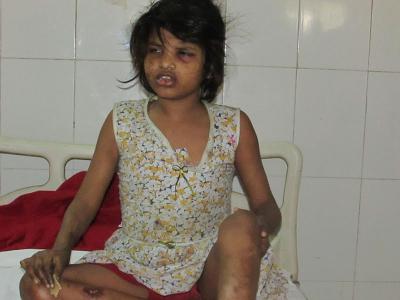Stamane mi è stata segnalata la storia di una bambina indiana che sarebbe stata allevata dalle scimmie. Leggiamo, per esempio, l’articolo de Il Fatto Quotidiano nell’articolo del 6 aprile 2017 dal titolo “India, trovata bimba “Mowgli”: viveva con un gruppo di scimmie“:
Una bambina di circa otto anni che viveva, come il mitico Mowgli del Libro della Giungla, allo stato brado, fra gli animali che la proteggevano e nutrivano. L’unica differenza fra il racconto di Rudyard Kipling e la realtà odierna è che Mowgli era stato adottato da un branco di lupi, mentre la bimba ritrovata in una foresta dell’Uttar Pradesh, che non ha ancora un nome, si accompagnava alle scimmie.
La stupefacente scoperta risale a due mesi fa, ma le autorità indiane l’hanno tenuta gelosamente nascosta per impedire l’inevitabile assalto dei media che avrebbe potuto compromettere il recupero psicologico e fisico della bimba.
Ma ora, dopo otto settimane, la storia è venuta alla luce e l’agenzia di stampa Ani ha raccontato che Suresh Yadav, un ispettore di polizia in pattugliamento nella Riserva naturale di Katarniaghat, non ha creduto ai propri occhi quando ha visto correre poco lontano da sé una bimbetta nuda, seminascosta da numerose scimmie. Quando il poliziotto si è avvicinato per rendersi conto della situazione, i primati e la bambina hanno cercato di respingerlo emettendo grida lancinanti. Con molta pazienza, però, alla fine l’ufficiale è riuscito a prendere la piccola con sé e a consegnarla ai medici di un ospedale locale.In una conferenza stampa oggi il responsabile della struttura sanitaria, dottor D.K. Singh, ha confermato che la bambina si comporta essenzialmente come un animale: mangia direttamente con la bocca, preferisce camminare aiutata da mani e piedi ed emette solo suoni gutturali, non capendo alcuna lingua. “Dopo settimane di cura – ha spiegato il medico – la sua salute è migliorata, e la sua posizione è prevalentemente eretta, anche se ha frequenti scatti di ira e continua ad emettere solo suoni incomprensibili, tentando di fuggire ogni volta che vede un essere umano”.
Anche il Times of India aveva diffuso la storiella via Twitter:
BAHRAICH: Cops in Uttar Pradesh have found a girl who can neither speak nor behave like normal human beings. The 8-year-old girl was rescued by the police in Bahraich from a troop of monkeys.
The girl was spotted by sub-inspector Suresh Yadav, who was on a routine patrol in Motipur range of Katarniaghat Wildlife Sanctuary.
When he tried to rescue the girl, who seemed to be comfortable with the apes, they screeched at him and so did the girl. However, the cops after great efforts managed to rescue the girl and got her admitted to the district hospital.
In un articolo dell’otto aprile 2017 del Guardian, dal titolo “Indian girl found in jungle was not living with monkeys, officials say“, leggiamo tutt’altra storia. Infatti, la bambina non è stata ritrovata in mezzo alla giungla mentre passeggiava con delle scimmie, ma è stata trovata in mezzo ad una strada nei pressi della stessa giungla dove i Rangers locali stavano effettuando un pattugliamento. Oltretutto risulta assurdo che fosse stata allevata fin da piccola dalle scimmie, siccome la giungla in questione è strettamente monitorata da telecamere e dagli stessi Rangers, il che risulterebbe molto strano che non se ne fossero mai resi conto della sua presenza per così lungo tempo.
Come mai si trovava li da sola e abbandonata? La bambina ha dimostrato una condizione di disabilità e, purtroppo, la sua famiglia non ha voluto prendersi cura di lei preferendone l’abbandono. In India è tristemente noto, come confermato al Guardian dall’attivista Ranjana Kumari, che il sesso femminile è molto discriminato dalle stesse famiglie (soprattutto nelle zone rurali), se poi subentrano situazioni di disabilità la loro condizione peggiora ulteriormente.
Con tutte le telecamere che ci potevano essere, come mai i Rangers non si sono resi conto del suo abbandono? Ripeto: la bambina è stata trovata in una strada nei pressi della giungla.
Evidenzio, in merito a questa storia, che il simpatico “Corriere della Sera” ha modificato i sui pezzi del 6 aprile 2017. Guardiamo i risultati ottenuti attraverso una ricerca Google:
Primo risultato: “Mowgli girl: in India trovata bambina selvaggia in una foresta – Corriere.it”
URL: http://www.corriere.it/video-articoli/2017/04/06/india-viveva-foresta-un-branco-scimmie-trovata-bimba-selvaggia/c9dd3bcc-1ae8-11e7-953e-ab8f663f73c7.shtml
Nuovo titolo: “La sindrome di Mowgli”Secondo risultato: “India: viveva nella foresta con un branco di scimmie … – Corriere TV”
URL: http://video.corriere.it/india-viveva-foresta-un-branco-scimmie-trovata-bimba-selvaggia/c9dd3bcc-1ae8-11e7-953e-ab8f663f73c7
Nuovo titolo: “La sindrome di Mowgli”
Peccato che hanno modificato il testo, mentre il video che accompagna entrambi gli articoli riporta la disinformazione contestata, così come le condivisioni via Facebook:

Per scrupolo ho provato a visualizzare l’anteprima della condivisione dalla mia pagina Facebook, ecco il risultato:

L’Ansa, invece, mantiene tutto invariato:

Extra
Ecco l’articolo del Guardian:
But far from being raised by animals in the Katarniya Ghat forest range, the girl, who doctors believe has mental and physical disabilities, was likely to have been recently abandoned in the wilderness by her carers, the district chief forestry officer said.
JP Singh said the girl was actually found on a roadside near the forest, not deep in the wilderness. And though there were monkeys in her vicinity, his rangers “never found this girl living with monkeys”, he said.
“I think the family members of this girl had been aware that she is not able to speak, and they may have abandoned her near the forest road,” he said. “If she was living with monkeys it would have been for a few days only, not for a long time.
“It is clear from first time view, if you see the girl, that she is only eight or nine years old, but her facial expressions show that she is disabled, not only mentally but also physically,” he said.
The forest is closely monitored by rangers and CCTV, and it was unlikely she could have survived in the wilderness for long without being spotted, he added.
The chief medical officer of the hospital in Bahraich, where the girl has been receiving treatment since she was found in January, said it was difficult to “say exactly when she was abandoned”.
“In India, people do not prefer a female child and she is mentally not sound,” DK Singh said. “So all the more [evidence] she was left there.”
Ankur Lal, the chief medical officer for Bahraich district, said the nature of the child’s disability was “still under investigation”, but it was unlikely she had been raised in the forest.
“When she was found, she was behaving violently. She had no toilet habits, no communication. So it was taken that she had been living in the jungle for long,” he said.
‘Eat mutton’: Indian newspaper’s ‘scientific’ tips for conceiving boys
Read more
But the rapid improvement she had made since being hospitalised now led doctors to believe she had in fact been raised by people. “Initially she was crawling but now she is walking normally – so she hasn’t been in the jungle since birth,” Lal said.“The truth of the matter is her family didn’t want to look after her,” said Ranjana Kumari a leading activist in the movement to promote the welfare of young girls in a society where female foeticide persists, and has severely distorted birth rates, especially in rural areas.
“Some families value girls less than boys,” she said. “They would rather get rid of the girl than spend money on her. It is a lot more responsibility because of the social environment we live in.”
She said the Indian state offered little help for poor families with disabled children – “and when it is a girl, it becomes double the issue”.
The girl will be moved on Saturday to a children’s home in Lucknow to continue her recovery.
Alcune foto della bambina.








